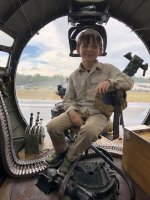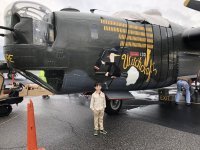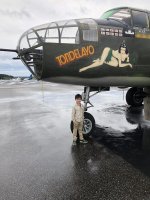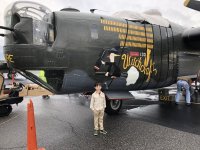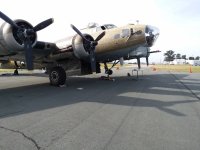It was alluded to in “The Rear Gunner” that gunners should be smaller men. Owing to the tight quarters for some gunners on bombers, AAF imposed an upper height and weight limit for gunnery school candidates of 5’10” and 170 pounds. No lower limits were mentioned. I have read that it has often been said that during WWII, belly turret and tail gunners had the highest fatality rate among bomber flight crews. But in fact their actual fatality rate is the same as for all other bomber flight crew members...
Back around 1985 or so, while visiting family in the area, I went to a World War II airshow at the Youngstown, Ohio, Airport. A B-17 was there, and an elderly gentleman (who was probably younger than I am now, come to think of it!) was standing by the tail wearing a "Flying Fortress" baseball hat.
I asked him what he'd done, and he told me he'd been a tail gunner. I asked how many missions he'd flown, and he told me fourteen. Seeing the quizzical look on my face, he explained that he'd been shot down on Mission #15...
They had just dropped their bombs on a target near Hamburg. The bomb bay doors wouldn't close, so the top turret gunner/flight engineer entered the bomb bay to use the hand crank to close them. While he was in there, an 88mm round hit the aircraft in the left wing, between the engines, and blew the wing off.
The Fort immediately rolled over to the left, pitching the engineer -- who was not wearing a parachute -- out of the bomb bay. The tail gunner clipped his 'chute onto his harness, and began trying to get to his emergency escape hatch, under the right horizontal stabilizer, fighting the G-forces all the way.
Despite the hatch being right behind his left shoulder, he could not get to it and open it until the B-17 was only about 1000 feet off the ground. He told me he thrust his legs through the opening, and pushed himself out.
When he landed, he was captured immediately, and the Germans took him to the crash site to identify his dead crewmates. He was the only survivor.
He told me this story matter-of-factly: This was what happened. I've wondered for years how men survived events like this and ever went on to live normal lives after the War...God bless them...

